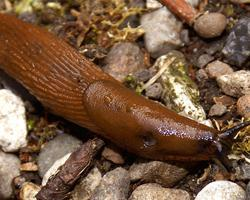
Poids et mesures
| Longueur | de 10 à 13 cm |
|---|
Description de l'animal
The Black slug (Arion ater), also known as the European black slug or the large black slug, is a terrestrial gastropod mollusk that is part of the Arionidae family. This species is notable for its considerable size and distinctive appearance, making it one of the more recognizable slugs in its habitat. Arion ater can be found across a broad geographic range, including much of Europe and parts of North America, where it has been introduced. It thrives in a variety of habitats, from gardens and agricultural lands to forests and grasslands, showcasing a remarkable adaptability to different environmental conditions.One of the most striking features of the Black slug is its size. It is among the larger species of slugs, with adults typically reaching lengths of up to 14 cm when fully extended, although sizes can vary. Its body is robust and muscular, allowing it to navigate its environment with surprising agility for a slug.
The coloration of Arion ater is another characteristic that distinguishes it from other slugs. Despite its common name, the Black slug's color can vary significantly. While many individuals exhibit a deep black or dark gray color, others may be brown, orange, or even red. This color variation can sometimes make identification challenging for those unfamiliar with the species. The slug's body is covered in a layer of mucus, which can appear shiny and helps in moisture retention, a critical aspect of its survival, especially in dry conditions.
The diet of the Black slug is varied and includes living plant matter, dead organic material, and even carrion. This dietary flexibility has implications for its role in the ecosystem. On one hand, it acts as a decomposer, breaking down dead plant and animal matter. On the other hand, it can be a pest in gardens and agricultural settings, where it may damage crops and ornamental plants.
Reproduction in Arion ater is hermaphroditic, meaning each individual possesses both male and female reproductive organs. Mating rituals are complex and involve a lengthy process of courtship and exchange of sperm. Eggs are laid in moist soil or under debris, where they remain until hatching. The lifecycle and reproductive habits of the Black slug are areas of interest for researchers, particularly in understanding its spread and impact on local ecosystems.
The presence of the Black slug in non-native regions, particularly in North America, has raised concerns about its potential impact on local habitats. As an invasive species, it can compete with native species for food and habitat, sometimes with detrimental effects.
In summary, the Black slug (Arion ater) is a fascinating creature with a wide range of adaptations that allow it to thrive in diverse environments. Its large size, variable coloration, and dietary habits make it a notable species within the gastropod community. However, its status as an invasive species in certain parts of the world highlights the complexities of human-mediated species distribution and the challenges of managing ecosystems in a way that preserves biodiversity.
Animaux similaires
Nouvelles photos d'animaux
Top 10 des animaux
- Dolphin gull (Leucophaeus scoresbii)
- Diana monkey (Cercopithecus diana)
- Moustached guenon (Cercopithecus cephus)
- Galápagos tortoise (Geochelone nigra complex)
- Japanese macaque (Macaca fuscata)
- Stone loach (Barbatula barbatula)
- Russian tortoise (Testudo horsfieldii)
- Greek tortoise (Testudo graeca)
- Common flying dragon (Draco volans)
- Vendace (Coregonus albula)
